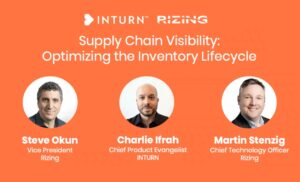
Experts from Rizing and INTURN discuss how a tool built on machine learning and artificial intelligence can predict slow-moving inventory, find inefficiencies in your sales process, shorten sales cycles, and increase profits.
It hasn’t been easy being a retailer lately.
COVID slowing down in-store traffic.
Supply chain issues causing gaps in your inventory.
The great resignation making employees hard to find.
Some retailer challenges are seasonal. Some are persistent.
Once in a while, an innovator comes along with a new solution that makes a persistent challenge yesterday’s news.
For consumer goods companies, one persistent challenge has been inventory.
“Traditional planning and forecasting never eliminate slow moving and excess inventory,” says INTURN’s Chief Product Evangelist Charlie Ifrah. “It’s due to many factors.”
Ifrah joined Rizing’s Martin Stenzig, Chief Technology Officer on a recent webinar to discuss those factors and how INTURN can help overcome them.
According to Ifrah, some of the factors affecting a retailer’s ability to manage their inventory includes:
- Social media trends
- Unplanned returns due to the COVID pandemic
- Low success rate of new products
- Double selling due to disconnected systems
- Lengthy sales cycles
- Lack of historical insights
So where is the innovation for retailers?
System of record
The first step, according to Ifrah, is getting to one source of data.
“Having a centralized system enables companies to work efficiently,” he says. “Everyone has visibility into what each other are doing with different sets of inventory.”
Centralizing core business data has long been a foundational step in helping businesses to work smarter.
Machine learning and artificial intelligence
The innovation comes from applying machine learning and artificial intelligence to that now-integrated data.
“Machine learning powers a prediction algorithm that helps companies identify what will become slow moving and obsolete,” Ifrah says. “It helps them analyze their current inventory levels. Using historical sales, forecasts, trends, expiration dates, and many more data points we are able to make those predictions well before humans can.”
Why an add-on?
Rizing’s Martin Stenzig talked about why SAP® looked to a third-party add-on to supply this functionality.
“We think that SAP in its core is covering very well,” Stenzig says. “But INTURN identified a clear white space in the SAP ecosystem which they are attacking. That is completely in line with SAP’s corporate strategy.”
INTURN adeptly filled that white space using SAP’s Business Technology Platform (BTP). According to SAP’s website, BTP “brings together intelligent enterprise applications with database and data management, analytics, integration and extension capabilities into one platform for both cloud and hybrid environments, including hundreds of pre-built integrations for SAP and third-party applications.”
Unilever case study
Ifrah outlined some results that the consumer goods company Unilever recorded after implementing the INTURN solution internally:
- 75% decrease in inventory file manipulations
- 29% decrease in the number of manual steps in selling process
- 36% decrease in offer duration (the time between creating an offer and closing a deal)
- $6.5 Million increase in year over year sales during a six month period
“It’s an efficiency tool for our users,” Ifrah says. “There’s so much extra work users would be doing without this platform.”
What’s the future hold?
Where does INTURN see their product going in the future?
“Making sure that our customers are as intelligent and informed as possible, says Ifrah. “Using data, machine learning and AI.”
Learn more
Learn more about optimizing your inventory lifecycle by viewing the entire conversation on the INTURN YouTube channel, or by visiting the INTURN website.
RISE with SAP and Rizing
To begin the journey of getting to that single source of data, visit RISE with SAP and Rizing.


